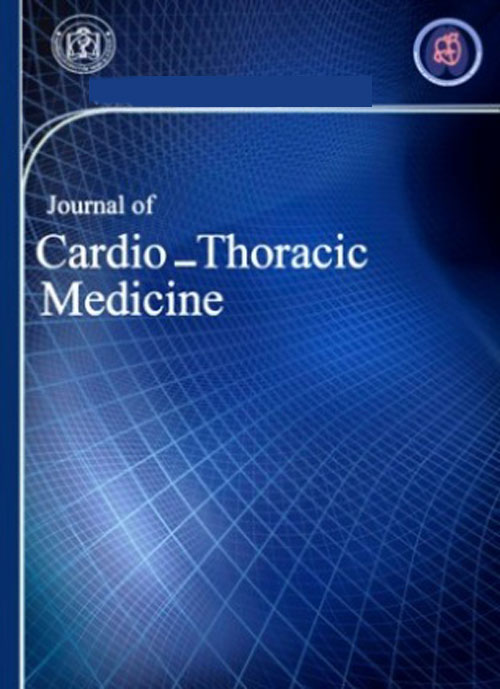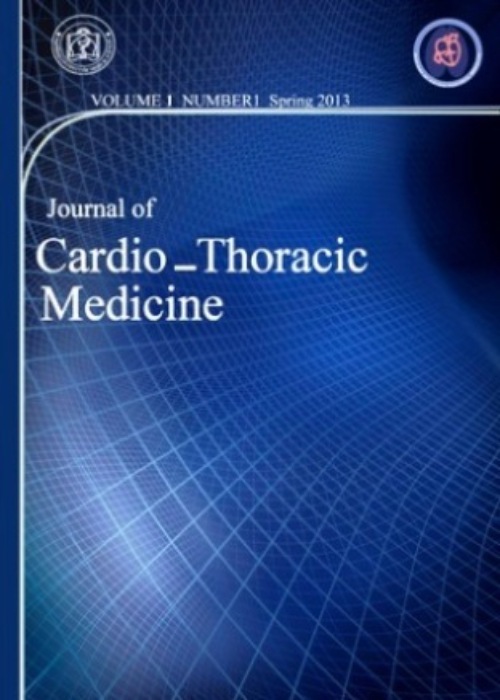فهرست مطالب

Journal of Cardio -Thoracic Medicine
Volume:4 Issue: 4, Autumn 2016
- تاریخ انتشار: 1395/09/23
- تعداد عناوین: 8
-
-
Pages 497-504Overlap syndrome, which is known as the coexistence of chronic obstructive pulmonary disease (COPD) and obstructive sleep apnea (OSA), was first defined by Flenley. Although it can refer to concomitant occurrence of any of the pulmonary diseases and OSA, overlap syndrome is commonly considered as the coexistence of OSA and COPD. This disease has unique adverse health consequences distinct from either condition alone. Given the high prevalence of each solitary disease, overlap syndrome is also likely to be common and clinically relevant. Despite the fact that overlap syndrome has been described in the literature for nearly 30 years, paucity of evaluations and studies limited the discussion on diagnosis, prevalence, pathophysiology, treatment, and outcomes of this disease. This review article addresses these issues by reviewing several recent studies conducted in Iran or other countries. This review suggests that overlap syndrome has worse outcomes than either disease alone. Our findings accentuated the urgent need for further studies on overlap syndrome and all overlaps between OSA and chronic pulmonary disease to provide a deeper insight into diagnosis and non-invasive treatments of this disease.Keywords: Chronic Obstructive, Overlap Syndrome, Pulmonary Disease, Sleep Apnea
-
Pages 505-508IntroductionHot flashes (HF) and night sweats (NS) are due to vasomotor instability and could be recognized as cardiovascular risk markers. Therefore, this study aimed to evaluate the relationship between vasomotor instability and severity of coronary artery disease (CAD) in postmenopausal women.Materials And MethodsThis observational cross sectional study, was performed in Chamran Hospital, Isfahan University of medical sciences, Isfahan, Iran from 2011-2012. In this study, womenwithin the age range of 45-60 years with angiography documented CAD were enrolled. Participants included 25 women with hot flashes, night sweats, or both and 17 women without these symptoms, respectively. In all participants, levels of follicular stimulating hormone/luteinizinghormone (FSH/LH) were measured. The severity of CAD was calculated using Gensini score. In order to evaluate the relationship between severity of CAD and other variables, Gensini scores lower than 50 and ≥50 were considered as low and high Gensini scores, respectively. Moreover, data analysis was performed using SPSS version 15.0.ResultsOur findings demonstrated that NS and HF were not associated with severity of CAD, determined by Gensini scores (P-values>0.05). However, a significant positive relationship was observed between FSH levels and severity of CAD in all participants (P=0.048). In cases in low Gensini score group, the relationship between LH and Gensini score was negative and non-significant, while Gensini score showed a positive and non-significant relationship (P-value> 0.05).ConclusionsNo significant association was observed between vasomotor symptoms of menopause and the severity of CAD. In addition, elevated FSH levels could be considered as a marker of severity of CAD.Keywords: Coronary Artery Disease, Gensini Score, Hot Flashes, Night Sweats
-
Pages 509-512IntroductionPsoriasis is a chronic inflammatory skin disease characterized by plaques covered with silvery scales. Psoriasis is highly prevalent in different countries in the world, including Iran. Several studies have reported a significant association between psoriasis and cardiovascular diseases. This study aimed to evaluate the relationship between psoriasis and cardiac disease using echocardiography.Materials And MethodsThis cross-sectional study was conducted in Imam Reza Hospital of Mashhad, Iran during 2013-2014 on patients with clinical diagnosis of psoriasis confirmed via biopsy. In addition, healthy volunteers homogenous in terms of age and gender were selected as the control group. Echocardiography was performed on patients and control subjects. Size of the left and right ventricles, left ventricle ejection fraction, diastolic function, and pulmonary artery pressure were recorded. In addition, patients were assessed in terms of the presence of valve regurgitation and disease severity.ResultsIn total, 23 patients with psoriasis and 23 control subjects were enrolled in this study. Mean duration of psoriasis was 7.0±9.1 years (range: 1-25 years), and disease severity ranged between moderate and severe. Left ventricular end-diastolic and systolic diameters were significantly higher in patients with psoriasis (P=0.030 and P=0.016, respectively). Moreover, left ventricular diastolic dysfunction was observed in 14 psoriasis patients (60.8%) and 3 control subjects (13.4%) (PConclusionAccording to the results of this study, patients with psoriasis commonly present with echocardiographic abnormalities, even in the absence of cardiovascular symptoms.Keywords: Cardiovascular disease, Echocardiography, Psoriasis
-
Pages 513-515IntroductionSurgical treatment of diseases in cervicothoracic, thoracic and thoracolumbar regions can be a challenging issue. Cooperation of the thoracic surgeons and spine surgeons can improve the outcomes and decrease the complications of patients who underwent these approaches.Materials and MethodsThe participants of this study consisted of seventeenpatients suffering from different types of vertebral lesions such as spinal TB, primary tumor, metastasis, and scoliosis. These patients were operated through anterior lower cervical incision (without sternotomy), standard thoracotomy, and lower thoracotomy during 2001-2016. For five patients, exposure of cervicothoracic region was achieved through anterior cervical incision with extension to anterior chest wall (without sternotomy). Through performing posterolateral thoracotomy (left or right) on nine patients, spine surgeons had a better access to the vertebral pathologies. In three cases, a perfect access to the thoracoabdominal spine was obtained by performing lower thoracotomy with removal of the twelfth rib and release of diaphragm from the chest wall.ResultsIn total, seventeen patients [eleven males (65%) and 6 (35%) females] with the mean age of 33.6 ± 19.4 were operated. 6 (35%) patients suffered from cervicothoracic lesions, 8 (47%)cases had lesions in middle and lower thoracic spine, and 3 (18%) patients had lesion in the thoracolumbar vertebra. Postoperatively, no mortality was observed in the patients and complications were reported to be minimal.ConclusionAccording to the findings, the joint corporation of thoracic and spine surgeons can improve exposure of cervicothoracic, thoracic, and thoracolumbar regions. Furthermore, this approach can decrease the complications of these complex surgeries.Keywords: Thoracotomy, Surgical Incisions, Spine Vertebral Column
-
Pages 516-521IntroductionPulmonary involvement secondary to Systemic Sclerosis (SSc) is the major cause of morbidity and mortality in SSc patients. We designed this study to determine the correlation of important lung function parameters with lung High Resolution CT (HRCT) scan findings.Materials And MethodsThirtytwo consecutive diffuse SSc patients with pulmonary fibrosis were enrolled in this cross-sectional study. Patients with pulmonary fibrosis secondary to other causes, previous restrictive lung disease, and history of smoking were excluded. Complete lung function evaluation was performed. The EDD (Exercise capacity, Dyspnea, and Diffusing capacity of lungs for carbon monoxide) index was determined. The Warrick score was calculated based on lung HRCT findings.ResultsThe mean age of the patients was 39.18 years ±9.39 (SD).Seventeen (53%) patients were in EDD stage 1 (score: 0≤score≤3), 9 patients (28%) in stage 2 (3ConclusionThe results of this study revealed that EDD may be a valuable representative marker of lung involvement in SSc and in the future, it can be a suitable and safe alternate modality comparing lung HRCT in our clinical practice and close follow-up.Keywords: High Resolution CT Scan, Lung Function Tests, Pulmonary Fibrosis, Scleroderma
-
Pages 522-526IntroductionInfective endocarditis is well known to produce neurologic complications from septic emboli, which mandates a multidisciplinary approach between neurosurgery and cardiac surgery. However, literature is not clear as to the optimal interval length between neurosurgery and cardiac surgery.
Presentation of Cases: The first case involves a 60-year-old woman with significant past medical history presenting with native valve methicillin-resistant staphylococcus aureus (MRSA) endocarditis causing cerebral vascular infarcts. The second case involves a 45-year-old man with no significant past medical history presenting with infective endocarditis of the aortic and mitral valve.DiscussionCardiac surgery was performed 27 and 17 days after neurosurgery intervention for each case, respectively. All operations were successful with few complications. Guidelines suggest waiting at least one week until valvular surgery, but other reports suggest earlier surgery produces preferable outcomes. In the cases presented, both patients experienced no further significant events to date after receiving cardiac surgery >3 weeks after the initial ischemic stroke event.ConclusionNeurological deficits mandate a collaborative approach between neurosurgery and cardiac surgery. Significance between time of neurosurgical intervention and cardiac surgery remains controversial, but waiting at least one week shows positive results.Keywords: Cerebral Vascular Accident, Craniotomy, Endocarditis, Mitral Valve Regurgitation, Mitral Valve Replacement -
Pages 527-528Psychological symptoms are considered as one of the aspects and consequences of cardiovascular diseases (CVDs), management of which can precipitate and facilitate the process of recovery. Evaluation of the psychological symptoms can increase awareness of treatment team regarding patients mental health, which can be beneficial for designing treatment programs (1). However, time-consuming process of interviews and assessment by questionnaires lead to fatigue and lack of patient cooperation, which may be problematic for healthcare evaluators. Therefore, the use of brief and suitable alternatives is always recommended.
The use of practical and easy to implement instruments is constantly emphasized. A practical method for assessing patient's psychological status is examining causal beliefs and attitudes about the disease. The causal beliefs and perceived risk factors by patients, which are significantly related to the actual risk factors for CVDs (2), are not only related to psychological adjustment and mental health but also have an impact on patients compliance with treatment recommendations (3).
It seems that several risk factors are at play regarding the perceived risk factors for CVDs such as gender (4), age (5), and most importantly, patients psychological status (3). Accordingly, evaluation of causal beliefs and perceived risk factors by patients could probably be a shortcut method for evaluation of patients psychological health. In recent years, Saeidi and Komasi (5) proposed a question and investigated the perceived risk factors with an open single item: What do you think is the main cause of your illness?. According to the authors, the perceived risk factors are recorded in five categories including biological (age, gender, and family history), environmental (dust, smoke, passive smoking, toxic substances, and effects of war), physiological (diabetes, hypertension, hyperlipidemia, and obesity), behavioral (lack of exercise, nutrition, physical work stress, cigarette smoking, and substance abuse), and psychological factors (stress, anxiety, mourning and depression, anger and rage, and spouse abuse) (5, 6). This instrument was designed in 2014 and has been employed in numerous studies (4).
The conducted studies using the open single item of perceived risk factors (OSIPRF) demonstrated that patients causal beliefs regarding CVDs could be a suitable instrument for screening for psychological symptoms, particularly anxiety and depression. In this regard, the results of a study showed that patients with a perceived risk factor experience higher levels of depression and anxiety compared with patients without a perceived risk factor (7). Furthermore, two studies revealed that patients with a physiological and/or psychological perceived risk factor experience higher levels of depression and anxiety compared with those with other classes of risk factors (6, 8). Therefore, management of their psychological status seems to be imperative.
Overall, it seems that application of the OSIPRF rather than time-consuming screening instruments is more affordable in terms of time, patient cooperation, diagnosis, and provision of timely services to those with adverse psychological status. Thus, given the knowledge of patient's regarding their psychological status and its management at disease onset may be beneficial in the process of physical recovery and returning to work, use of this diagnostic method by health professionals in the field of CVDs is recommended.Keywords: Cardiovascular Diseases, OSIPRF, Perceived Risk Factor, Psychological Symptoms, Screening Instrument -
Page 529In this case report, we described a 74-year-old female patient with major complaint of respiratory problemsdyspnea after meal. Chest X-ray of the patient revealed a gianttype IV hiatal hernia. Preoperative evaluations of the patient included esophagoscopy, esophageal manometry, barium swallow, and CT-scan. Repair of the hernia was performed using a dual mesh on the diaphragm and partial anterior fundoplication (Dor fundoplication). After a six-month follow-up, the overall condition of the patient is satisfactory, exceptmild intermittent dysphagia due to esophageal dysmotility.Keywords: Surgical, Repair, Hiatal Hernia


